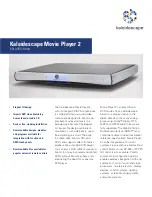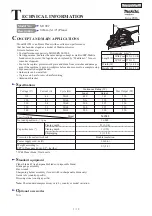
16
CFD-CD777SMK2
Focus Tracking/Gain Adjustment
A frequency response analyzer is necessary in order to perform
this adjustment exactly.
However, this gain has a margin, so even if it is slightly off, there
is no problem. Therefore, do not perform this adjustment.
Focus Tracking/gain determines the pick-up follow-up (vertical
and horizontal) relative to mechanical noise and mechanical shock
when the 2-axis device operate.
However, as these reciprocate, the adjustment is at the point where
both are satisfied.
• When gain is raised, the noise when the 2-axis device operates
increases.
• When gain is lowered, mechanical shock and skipping occurs
more easily.
• When gain adjustment is off, the symptoms below appear.
The following is a simple adjustment method.
– Primary Adjustment –
Note:
Since exact adjustment cannot be performed, remember the posi-
tions of the controls before performing the adjustment. If the posi-
tions after the primary adjustment are only a little different, return
the controls to the original position.
Connection:
• The time until music starts becomes longer for
STOP
→
NX
button or automatic selection.
(
.
,
>
buttons pressed.)
(Normally takes about 2 seconds.)
• Music does not start and disc continues to
rotate for STOP
→
NX
button or automatic
selection.
(
.
,
>
buttons pressed.)
• Sound is interrupted during PLAY.
Or time counter display stops progressing.
• More noise during 2-axis device operation
Gain
Focus
Tracking
Symptoms
low
low
or
high
–
low
–
low
high
high
+
–
Solder bridge (TRACKING)
Solder bridge (FOCUS)
TP (VC)
oscilloscope
(DC range)
Focus Bias Adjustment
This adjustment is to be done when the optical pick-up is replaced.
Procedure:
1. Connect the oscilloscope to solder bridge (FOCUS) and TP
(VC) on the MAIN board.
2. Put the set into test mode. (See page 24.)
3. Optical pick-up setting to the center by
>
or
.
button
pushing. (Move the optical pick-up to the music area on the
disc to enable easy visibility of the eye pattern.)
4. Put the disc (YEDS-18) and press
NX
button.
From focus searching, focus is turned ON while entering
CLV drawing-in mode. Tracking and sled are turned OFF.
5. Press the
NX
button.
[Both tracking and sled are turned ON.]
6. Adjust RV701 so that the oscilloscope waveform is as shown
in the figure below (eye pattern).
A good eye pattern means that the diamond shape (
≈
) in the
center of the waveform can be clearly distinguished.
7. Release the test mode after adjustment is completed.
• RF signal reference waveform (eye pattern)
Adjustment Location: MAIN board (See page 18)
+
–
MAIN board
Solder bridge (FOCUS)
TP (VC)
oscilloscope
(AC range)
VOLT/DIV: 0.2 V (with the 10: 1 probe in use)
TIME/DIV: 500 ns
1.2
±
0.2 Vp-p
When observing the eye pattern, set the oscilloscope
for AC range and raise vertical sensitivity.
Summary of Contents for CFD-CD777S MK2
Page 64: ...64 CFD CD777SMK2 MEMO ...
















































